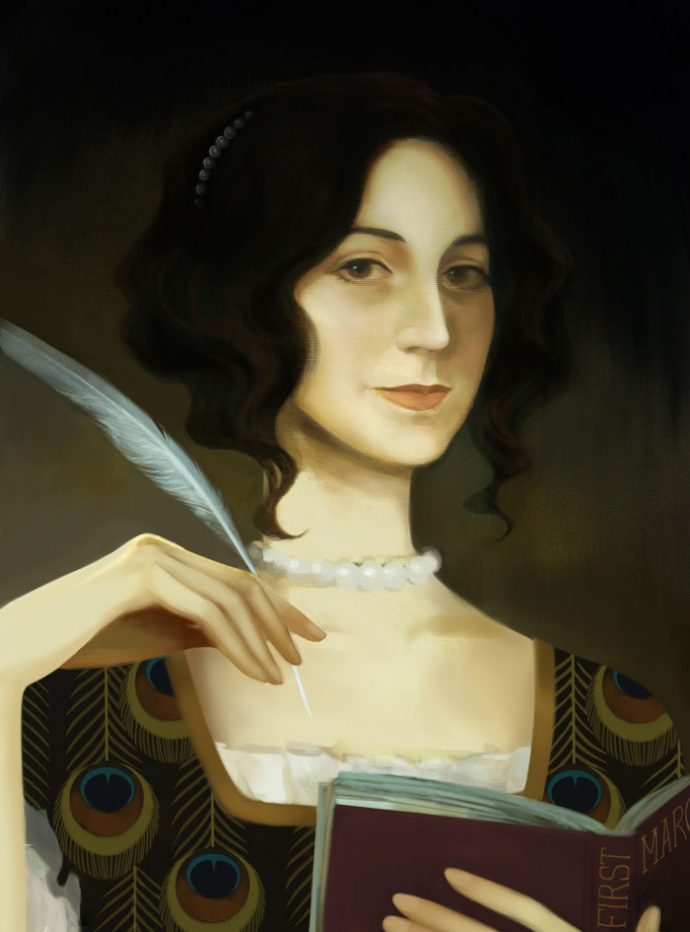—Danielle Dutton, Margaret the First
Washington University English Professor Danielle Dutton is the type of writer whose prose seems to transform entirely between each book she writes. All of her four works have taken on distinctly different forms. In her first book, Attempts at a Life, short pieces slip between poetry and prose, ekphrasis and theory. Her second, SPRAWL, eschews the brevity of Attempts; it is a suburban novel told in one paragraph. Here Comes Kitty: A Comic Opera, a collaboration with artist Richard Kraft published in 2015, features collages interspersed with Dutton’s written interludes. But for all her acrobatic shifts of form, what unifies Dutton’s prose is a litheness of language and imagination that always surprises.
Dutton’s latest book, Margaret the First (Catapult, 2016), is a novel about the life of English Restoration-era writer and public figure Margaret Cavendish. Though it draws from historical sources, Margaret is a novel that feels anything but historical. Through short sections that feel like portholes into the life and voice of Margaret, Dutton follows her protagonist from childhood to death, weaving a portrait of a delightfully daring and complex woman who was both ahead of her time and exactly within her time, wondering through her quill about the workings of the world and her place within it while all of England was abuzz with a new fervor for philosophy and literature and empirical science.
Christina Wood Martinez: All three of your books have engaged with another work of art in some way: with Jane Eyre and other texts and figures in Attempts at a Life, with Laura Letinsky’s still life photos in SPRAWL, and now with the life and work of Restoration era writer and aristocrat Margaret Cavendish in Margaret the First. I’m curious to know about what it is and why it is that you draw from these sources when you write? Was it different for each book?
Danielle Dutton: The quick answer is that I don’t find myself all that interesting. I don’t mean that in a cruel way, but I’ve tended to be more interested in what happens when my patterns of thinking/experience bump up against other people’s thoughts or experiences. There’s a way in which my process is constraint-based, then, without being truly constraint-based. Or it’s collaborative without being truly collaborative. Of course no artist works in a vacuum, I just tend to draw a lot of attention to the works that get my own work going.
Did it feel different with each book? Yes and no. I never actually set out looking for something to respond to. It’s more like a confrontation. The responses come out of my being struck by something in the world, something I wasn’t expecting, whether a painting, a poem, a line of prose, or a personality. So in that way there’s some similarity, some kinship to the way the pieces might have started, but then each work develops its own needs. In fact, I think I generally know I’m on to something when I can’t tell what to do, when I’m not just repeating old methods that worked in the past.
CWM: When writing fiction about someone who really lived, there could be a lot of pressure (positive or negative) to write a character a certain way—to be true to biographical fact, to honor them, or to please their fans. I wondered about whether you felt any those types of pressures while writing about Margaret and how they might have played out in the book?
DD: Oh god, yes. If there are pressures to be felt, I promise I will feel them. Actually, wait: I felt fairly unburdened when I started writing about Cavendish. I suppose something about the very beginning of a project—having no idea where you’re going with it—is just a very liberating space. For me, when I start something, I’m always pretty sure it won’t go anywhere, that no one will ever read it, etc. So that’s sort of depressing on the one hand, but on the other hand it also means I feel free to do whatever pleases me. So, yes, in the beginning I felt a little like anything goes. But it didn’t take too long for me to start to question what might or might not be—ethical, I guess?—in fictionalizing an actual person’s life. Naturally there are aspects to her life that I felt I needed to ignore or simplify for the sake of the story I was telling, and I made up plenty as well, but I did try to not stray too far from what seemed reasonably “true” about her. At times that felt constricting, as if I wasn’t free to just write. Yet her life was so compelling that sticking closely to it wasn’t ultimately a hardship.
As for her fans: weirdly, I did very little googling of Margaret Cavendish. I read books about her and by her, essays about her work, but I didn’t scour the internet, and so I really had no idea who out there might even be a Margaret Cavendish fan. It was only very late in the writing that I realized, for example, that there is a Margaret Cavendish Society. Of course there is! Perhaps unconsciously I didn’t want to know? I think it was necessary for me to feel alone with her, to feel she belonged to me.
CWM: I was really struck by the shift in point of view that occurs in each of the three parts of the novel. Conventionally, a writer chooses whether they want to write about a character, using the third person, or write a character, letting them tell their story in their own voice, but you do both! The novel begins in Margaret’s voice, following her account of her childhood, marriage, and early writing career. When she begins to become a public figure (the king, of all people, calls her a celebrity!), you switch to third person and give us a greater sense of the world that surrounds her and the many eyes on her (“A mad, conceited, ridiculous woman,” Samuel Pepys said of her). Could you talk a bit about the origins of those shifts in point of view and why they became important to the shape and scope of the novel?
DD: Well, yes, that’s it: I wanted the novel to get close to her and to observe her. This felt important to who she was, and for the reader’s experience of her, and for my presentation of her as at once a character in a novel and a figure from history. I didn’t sit down planning to write it this way, however. The book itself seemed to want to shift away from her at the start of the second section, for example, and I fought it a little at first. But at that point in her life, at the beginning of the historical period known as the Restoration, returning to England after more than a decade in exile, I imagine Margaret would have felt somewhat alienated, lost, and so switching from first to third there eventually just felt right. And then, too, there’s the (even stranger?) shift to Samuel Pepys’s POV right after the book’s climactic scene at the Royal Society of London. This is the book’s most dramatic gesture toward “an outside view” of Margaret, and again it just felt right, since a large part of what the book is about is the “problem” of her persona.
CWM: Jenny Offill blurbed Margaret and aptly pointed out that though the novel is set in the seventeenth century, it is a “feminist novel with modern insights into love, marriage, and the siren call of ambition.” I see the modern sensibilities and feminist aims of the novel coming into play in the content of the novel—you give voice and depth to Margaret, who with the nickname “Mad Madge” had been turned into something of a literary caricature—but I also see that modernity in the language you use. Sure, there’s a “hath” or two in the dialogue, but the prose has none of the stuffiness of antique literature. “Finally something happened, or almost did: Marie de’ Medici came to England,” teenage Margaret says, for example, with age-appropriate attitude. I wonder if “updating” Margaret’s image was part of your project from the beginning? How did you go about finding Margaret’s more modern voice?
DD: That’s so funny, I was just thinking about this whole idea of “updating” last night as I re-watched the most recent adaptation of Pride and Prejudice, the one with Keira Knightly as Elizabeth Bennet. I’d seen it in the theater when it came out, and I remember being totally furious about it. I don’t remember who I went with, but I’m sure I was an absolute pain in the ass about it. I just couldn’t understand why they’d felt they needed to take the liberties they’d taken with the book (or the time period itself). I remember I didn’t think those choices to “update” the book (Elizabeth and Darcy canoodling at Pemberly post-marriage, or Bingley bursting into Jane’s sickroom) added anything of real value; instead it seemed to me those choices only made the book (or at least the film) slightly ridiculous. Anyway, this time I went in knowing my prejudice and wanting to see the film for itself without only holding it up to the book. I liked it more (a little more . . . it’s still nowhere near as good as the Colin Firth miniseries, obviously), but I also had to remind myself to stop tensing up about it, like I was literally clenching my shoulders and squinting a little as I watched. All this is to say: no, I’m not sure I did ever hope to “update” anything about Margaret, but I did think about how to make her accessible. Is that updating? Because while I wanted the period itself to feel right and very tangible, I also wanted her to feel completely alive, right now, inside my book. Part of how I went about doing that involved this long process of letting myself into the character I was writing, which meant letting her be even more a character and less a figure. It was definitely a balancing act.
CWM: If Margaret Cavendish could by some means (afterlife library?) read your novel, would you want her to? She was a writer who was very clear in expressing her great desire for fame. Do you think she would be pleased that you’ve written a novel about her?
DD: I’m tempted to turn this one around: what do you think?
CWM: Well, one of my favorite things about your portrait of Margaret is that you capture her complications so beautifully—you don’t try to resolve her contradicting personality traits (she is sometimes a braggart, sometimes terribly shy). Rather, you let them be, and she seems all the more human for it. So, I think she would be both unnerved and tickled to have a novel written about her. I imagine she would publicly deny having read Margaret the First, but would secretly keep a copy under her pillow.
DD: I love that. Thank you. I’m so glad I asked you to answer it instead.
CWM: You are also the founder and editor of the small press Dorothy, a publishing project. When you first decided that you wanted to start your own press, how did you go about deciding what your aims and aesthetics were? Have those changed or expanded at all in the six years since you began?
DD: I wanted to start a press, in part, in order to feel collaboratively engaged with writers I admired. But I also wanted to start a press that seemed to me to have a reason for existing beyond simply putting more books into the world. So I thought about it for a long time before Dorothy itself took shape. What emerged was this idea of a press that would focus on important, innovative writing by (mostly) women, not to ghettoize women writers but to shine a spotlight on, and thereby perhaps force a conversation about the incredible diversity of serious, wild, strange, and engaging work being written by (mostly) women. Because at that moment, it seemed to me that a lot of the conversations about innovative writing were (mostly) about men’s books or were happening (mostly) in men’s mouths. Some of those conversations were interesting to me, but they largely overlooked the writers I was excited about, writers like Renee Gladman or Bhanu Kapil or Ann Quin or Leonora Carrington or Amina Cain, for example.
So, to speed this up: I found out Renee had a series of novels she was writing about an invented city-state called Ravicka, and so I contacted her and basically said, “If you’ll let me publish your books, I’ll start a press,” and she, miraculously, said yes. Once we had Renee’s first book in this series, Event Factory, we started to look for a book to pair it with, something unlike it but which, when placed beside it, might spark an interesting conversation about what fiction can do and be. Each year this has been our mode of operation: to pair two books that draw upon different aesthetic traditions, since a large part of our interest in literature lies in its possibilities, its endless stylistic and formal variety. In this sense, I’d say our aims and our aesthetics are much the same now as they were when we published Event Factory beside Barbara Comyns’s Who Was Changed and Who Was Dead in 2009. This fall, our seventh year, we’re bringing out a debut collection of some of the weirdest and most brilliant stories I’ve read, by a writer named Jen George—it’s called The Babysitter at Rest—and pairing it with the first US edition of a translation of Suite for Barbara Loden, a gorgeously smart award-winning French novel by Natalie Leger, which is, in large part, about Barbara Loden’s enigmatic 1970 film Wanda.
CWM: I know you worked as the book designer for Dalkey Archive Press. Did your time at Dalkey play a role in shaping your vision of Dorothy?
DD: Yes, absolutely. I would not have been able to do Dorothy the way I’ve done it if I hadn’t worked at Dalkey. I’m very grateful for that experience. To start, I’d long admired Dalkey’s list, the seriousness of its mission and the important and daring books it makes available to American readers. It was there that I learned how to make a book, how to physically make that happen, and I discovered that I really loved doing it, the whole production. I just learned so much about publishing at Dalkey, how it works day to day, everything from copy editing, to InDesign, to distribution. And even after all that, I wouldn’t have been able to do it without my husband, Marty, who’d been Dalkey’s associate director for over a decade. I’m not saying a person can’t start a press without that past experience, but I doubt we would have had quite the success we’ve had without it. And then, too, there were naturally the ways in which being there made me see how I might do things differently if I had my own press: in the last year or two I was there, for example, Dalkey was, in my opinion, publishing too many books a year for the size of its staff. I’m sure the publisher had his reasons for doing that, but from my own perspective I didn’t like the feeling of moving through jobs so quickly. I wished I had more time for each book, which might sound utopian, but I suppose there was always something a bit utopian about the plans for Dorothy. Anyway, Marty and I decided from the outset that Dorothy would be a “slow” publisher—low overhead but with plenty of time spent on each book, so that the press itself, the work of it, would be something we could sustain for years without burning out, without going bankrupt, etc.
Christina Wood Martinez is Washington University’s Junior Writer in Residence for Fiction and the editorial assistant for Dorothy, a publishing project.




